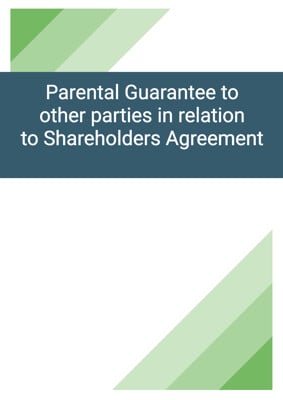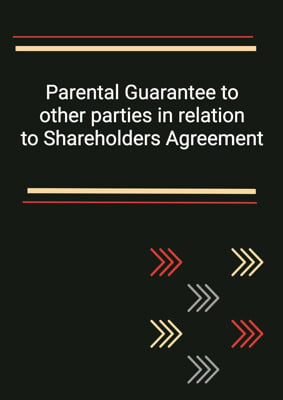How to Tailor the Document for Your Need?
01
Create Document
Fill in the details of the parties. You can click the "Fill with Member’s Information" button to complete it with information saved to your account.
02
Fill Information
Please fill in any additional information by following the step-by-step guide on the left hand side of the preview document and click the "Next" button.
03
Get Document
When you are done, click the "Get Document" button and you can download the document in Word or PDF format.
04
Review Document
Please get all parties to review the document carefully and make any final modifications to ensure that the details are correct before signing the document.
Document Preview
Document Description
The Shareholders Agreement - Equal Shares in Company is a legally binding document that governs the relationship between Party 1 and Party 2 as shareholders in a jointly-owned company. The agreement highlights the importance of forming the company and establishes the terms and conditions under which the shareholders will operate.
The document begins with an interpretation section, which provides definitions for key terms used throughout the agreement. This ensures clarity and understanding between the parties. The agreement also includes statutory provisions, which ensure that the document complies with relevant laws and regulations.
Section 2 of the agreement covers the establishment of the company. It outlines the process of incorporating the company and specifies the characteristics it should have, such as its name, share capital, and registered office. The completion of the establishment is also defined, including the necessary events and transactions that need to take place.
Section 3 focuses on the capital, further finance, and dividend policy of the company. It states the share capital of the company and allows for its increase by agreement of the parties. The section also addresses the provision of further finance, the repayment of loans, and the distribution of dividends.
Section 4 deals with the directors and management of the company. It establishes the board of directors and outlines the process of appointing and removing directors. The section also covers the quorum, voting rights, and decision-making process of the board.
Section 5 addresses reserved shareholder matters, which require the prior approval of both parties. These matters include issues such as the issuance of shares, sale of the company, alteration to the memorandum and articles, and borrowing by the company.
Section 6 outlines the transfer of shares and the process for selling or disposing of shares by either party. It includes provisions for transfer notices, purchase notices, determination of fair price, and the sale of shares to third-party purchasers.
Section 7 focuses on confidentiality and requires both parties to keep any information related to the company or the other party confidential. It also imposes similar obligations on the company and its subsidiaries.
Section 8 imposes restrictions on the parties, preventing them from engaging in any competing business during the term of the agreement.
Section 9 defines the term of the agreement and the conditions for termination. It allows either party to terminate the agreement by giving prior notice, and it provides for the liquidation of the company upon termination.
Section 10 establishes the supremacy of the agreement over the memorandum and articles of the company, ensuring that the provisions of the agreement prevail.
Section 11 addresses the costs of incorporation and the preparation and execution of the agreement, stating that each party shall bear its own costs.
Section 12 clarifies that the agreement does not create a partnership or agency relationship between the parties.
Section 13 confirms that the agreement, along with any other agreements entered into on completion, constitutes the entire agreement between the parties.
Section 14 emphasizes mutual consultation and goodwill between the parties, promoting the best interests of the company.
Section 15 prohibits the assignment of the agreement or any rights or obligations under it, except for the transfer of shares in accordance with Section 6.
Section 16 (if applicable) covers conditions precedent to the completion of the agreement, outlining the conditions that must be fulfilled or waived before completion.
Section 17 states that any variation of the agreement must be in writing and signed by the parties.
Section 18 clarifies that the agreement does not confer any rights on third parties to enforce its terms.
Section 19 provides for the resolution of disputes, stating that any legal proceedings shall be subject to the jurisdiction of the relevant court.
Section 20 allows the agreement to be executed in counterparts, with each counterpart being considered an original.
Section 21 addresses severance, stating that if any provision of the agreement is deemed illegal, void, or unenforceable, it shall be removed or replaced with a valid provision.
Section 22 covers notices and service, specifying the methods and requirements for giving notice under the agreement.
The Shareholders Agreement - Equal Shares in Company is a comprehensive document that covers all aspects of the shareholders' relationship and the operation of the company. It ensures clarity, fairness, and protection for both parties involved.
How to use this document?
1. Incorporation: As soon as possible after the agreement is signed, both parties should take the necessary steps to incorporate the company in accordance with the agreed characteristics outlined in Section 2.
2. Share Capital: After incorporation, the company should have an issued share capital consisting of shares owned by each party in the agreed proportions. Ensure that the share capital is accurately recorded and maintained.
3. Further Finance: If the company requires additional finance, the board should first approach its own bankers. If finance cannot be obtained from the company's own bankers, both parties should agree on providing finance in equal proportions.
4. Directors and Management: Establish the board of directors in accordance with Section 4. Each party should appoint and maintain directors, ensuring that the board is constituted as agreed. Hold regular board meetings, provide proper notice, and keep accurate records of decisions made.
5. Reserved Shareholder Matters: Obtain prior approval from both parties for any matters listed in Section 5 that require approval. This ensures that important decisions are made jointly and in the best interest of the company.
6. Transfer of Shares: If a party wishes to sell or dispose of shares, they must give a transfer notice to the other party. The continuing party has the right to purchase the shares at the specified price. If no agreement is reached, the fair price should be determined by the auditors. Follow the process outlined in Section 6 to complete the sale and purchase of shares.
7. Confidentiality: Both parties must maintain confidentiality regarding any information related to the company or the other party. Ensure that employees and agents also adhere to this obligation.
8. Restrictions on the Parties: Neither party should engage in any competing business during the term of the agreement, except for permitted investments. Comply with this restriction to avoid conflicts of interest.
9. Term and Termination: The agreement has a minimum term, and either party can terminate it by giving prior notice. If termination occurs, follow the process outlined in Section 9 to ensure a smooth transition and the liquidation of the company if necessary.
10. Supremacy of the Agreement: Ensure that the provisions of this agreement are followed and take precedence over the memorandum and articles of the company.
11. Costs: Each party is responsible for its own costs related to the incorporation and execution of the agreement.
12. No Partnership or Agency: Understand that this agreement does not create a partnership or agency relationship between the parties.
13. Entire Agreement: This agreement, along with any other agreements entered into on completion, constitutes the entire agreement between the parties. It supersedes any previous representations or warranties.
14. Mutual Consultation and Goodwill: Act in good faith and consult with each other on matters affecting the development of the business. Promote the success of the company and maintain a positive working relationship.
15. Assignment: Neither party can assign this agreement or its rights and obligations without proper transfer of shares. Follow the process outlined in Section 6 for any transfers.
16. Conditions Precedent: If applicable, ensure that all conditions precedent outlined in Section 16 are fulfilled or waived before completion.
17. Amendment: Any changes to the agreement must be in writing and signed by the parties. Changes do not affect rights, obligations, or liabilities that have already accrued.
18. No Rights of Third Parties: Understand that third parties do not have the right to enforce the terms of this agreement.
19. Dispute Resolutions: In case of disputes, legal proceedings should be subject to the jurisdiction specified in the agreement.
20. Counterparts: The agreement can be executed in multiple counterparts, with each counterpart considered an original.
21. Severance: If any provision of the agreement is deemed illegal, void, or unenforceable, it should be removed or replaced with a valid provision.
22. Notices and Service: All notices under the agreement should be in writing and served according to the specified methods and requirements in Section 22. Keep accurate records of notices and ensure timely delivery.
Not the right document?
Don’t worry, we have thousands of documents for you to choose from:


























